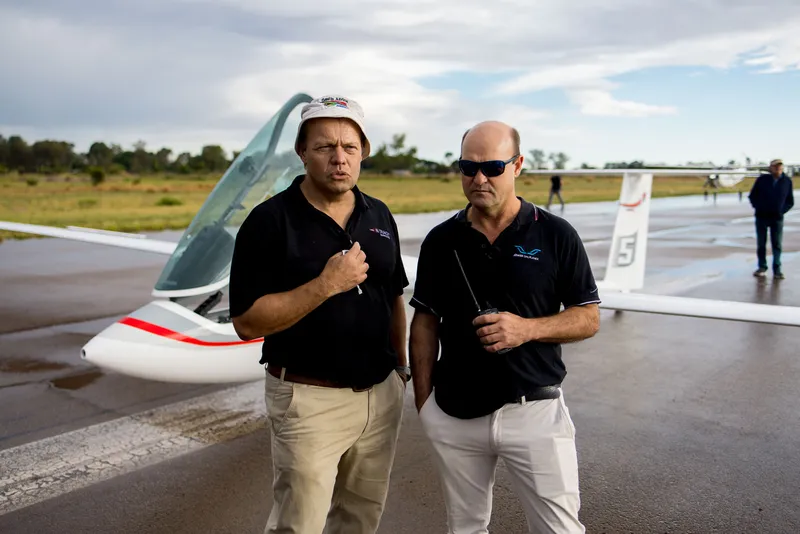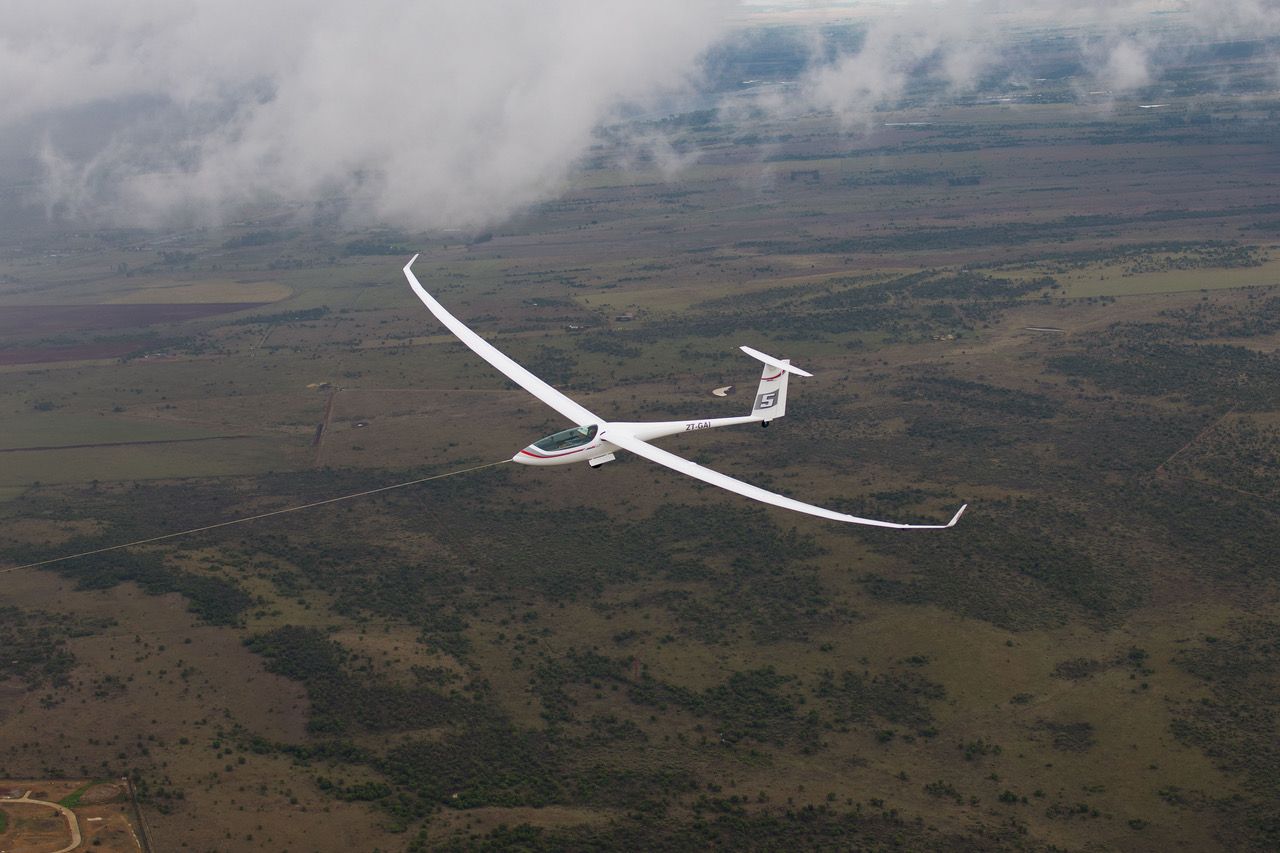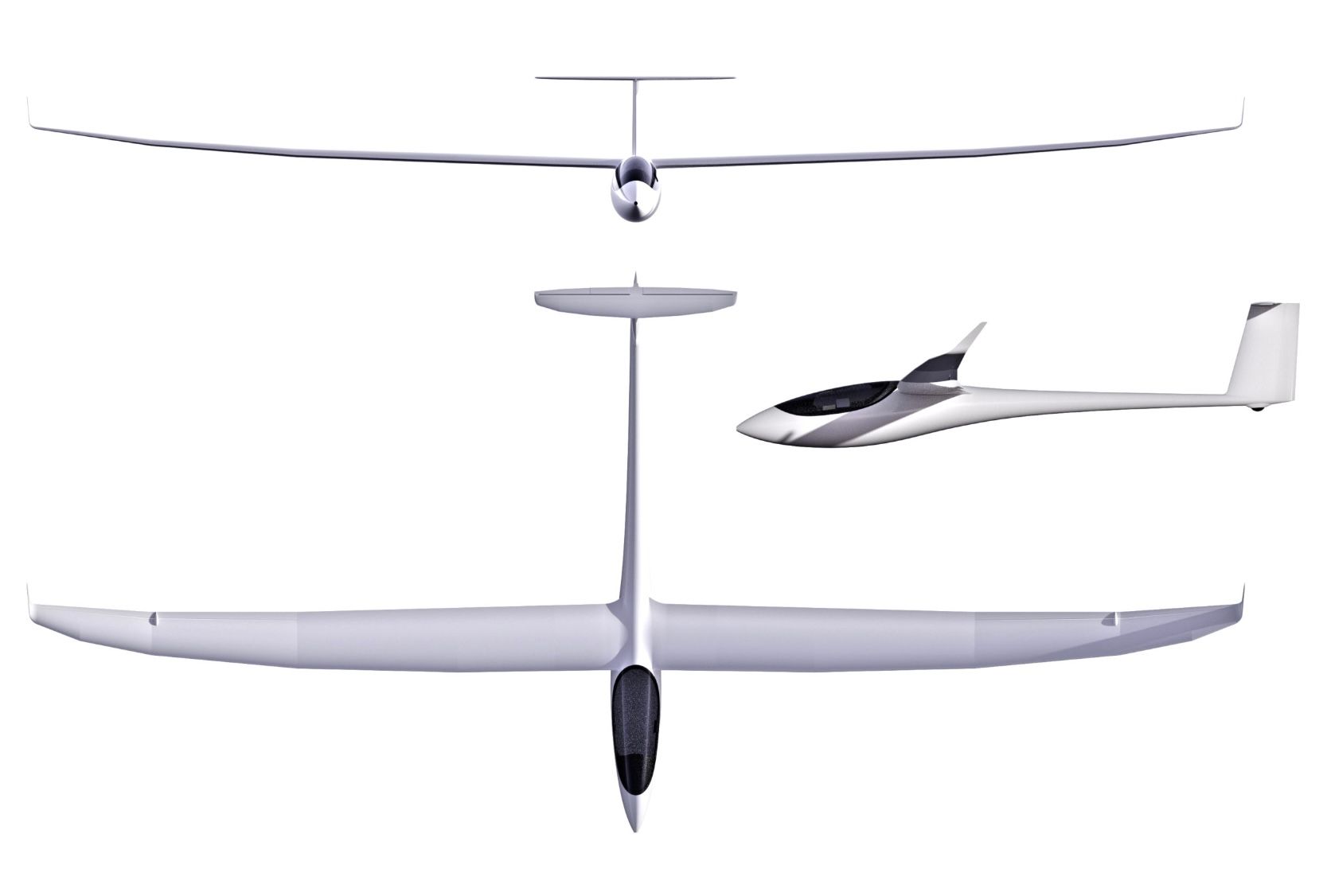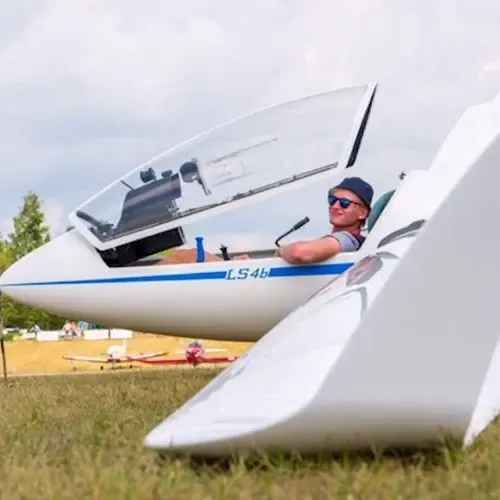Jonker Sailplanes | Back to Open Class with the JS5

As part of our series on glider manufacturers, we meet with Uys Jonker. Uys is not only known as the public face of Jonker Sailplanes but also as a distinguished glider pilot, having participated in multiple world championships. We catch him early in the morning in his office in Potchefstroom, South Africa.
Uys, tell us about the idea and vision of Jonker Sailplanes.
Our vision for a long time was to apply our skills and abilities in constructing gliders to make some of the best sailplanes in the world. We wanted to compete with the German manufacturers and fly against their top aircraft. This achievement was already a great milestone for our team.
As Jonker Sailplanes developed into a bigger business, we realized that the interaction with our customers is very rewarding. It's a big gliding family and producing gliders for our friends around the world is a big motivation. It doesn't matter what type of glider someone is flying if it is from JS or from any other manufacturer. Visiting gliding competitions is always like a family gathering. Building these products gives us amazing opportunities to be part of the huge gliding family and meet amazing people.
Additionally, engaging in the technical race against other manufacturers, akin to Formula One, fuels our product-driven approach. This competition stimulates the market and ensures our continuous innovation. Striving to have the best product is like trying to hit a moving target because every manufacturer is working hard to be the best.
Are you still doing engineering at Jonker?
While actively engaged in product development, my role has transitioned from hardcore engineering. Drawing on my background as a system engineer for fighter aircraft, I now oversee flight test programs, manage flight manuals, and handle weight and balance calculations. These responsibilities ensure my continued immersion in the technical facets of our products.
Congratulations on the maiden flight of the JS5. Tell us about the aircraft.
We didn't originally plan to enter the open class. It all began before the 2014 Uvalde World Championship when we received a request to certify the JS1 for over 600 kg to make it competitive in the open class. Intrigued, we crunched the numbers and pondered: What if we extended the wings and significantly increased the mass?
This decision resulted in the release of the JS1 C with a 21-meter wingspan in Uvalde, a move that notably shifted the dynamics of the open class. The Nimbus 4 and the ASW 22 lost their competitive edge. Simultaneously, Binder introduced the EB 29, making a significant impact.
Subsequently, with the release of the EB 29R, our sales in the open class dwindled. A continuous debate followed on whether we should re-enter the open class. After extensive discussions, we concluded that a mere extension of the JS1 wouldn't suffice; we needed an entirely new wing.
This led us to ponder: What's the optimal aircraft we can create for the open class? It necessitated a slightly larger span than the JS1 but with a smaller inner wing. The decision to push the launch button for this new product was met with uncertainty as we carefully weighed our options.

You can lose a lot of money developing open-class aircraft, and the market is relatively small in size.
Yes, it's indeed a costly endeavor. However, having a top-of-the-line product in our portfolio is crucial. It sends a clear message to the market: we are serious contenders capable of building state-of-the-art gliders.
What made the decision viable was our expertise in wing development, a process much quicker than creating a new fuselage. With the JS2 design already completed, we had a head start as the fuselage was ready. This meant that the development cost was only about a third of the time it took for the JS2. So, after careful consideration, we decided to push the button.
What were your performance goals with the JS5?
Looking at gliders in general, the 18m class is very close to the open class in good conditions. But there are areas where the open class is just a lot better: during the early and late part of the day when thermals are much weaker. Many pilots nowadays don't focus on competitions, but rather on flying long distances or traveling with their glider, thus requiring the complete spectrum of the available energy.
Our main goal with the JS5 was to climb really well in small broken thermals, and that has significantly improved compared to the JS1 C. Also, we want to be really good at high speeds, and the polar suggests that we really have great performance in that area.
The EB 29R is notably superior, particularly in challenging conditions where the JS1 C faces limitations. Therefore, a pivotal design objective for the JS5 was achieving a lightweight structure. With an estimated empty weight of around 480 kg, the JS5 boasts a minimum wing loading of approximately 43 kg/m2. This emphasis on reduced weight not only improves ground handling but also makes the glider exceptionally adept at utilizing the last thermals of the day.
How did you arrive at the decision for a 24.2-meter wing?
Our goal was to design the ultimate open-class glider, and the design team worked without predefined wingspan limitations. Through extensive calculations, while considering material constraints (despite utilizing high-tensile carbon), we assessed performance across various wingspans. After multiple iterations, calculations revealed that the optimal performance peak was achieved with a modest wingspan of 24.2 meters.
Notably, this smaller wingspan design not only suggests superior performance but also provides advantages in terms of in-flight handling and ground operations. In a hypothetical scenario with unlimited material stiffness, larger and longer wings would always be the preferred choice.
Will there be different wingspans for the JS5?
The wing's junction break position enables spans ranging from 18 to 24 meters on the JS5, with the current design dedicated to 24 meters. While shorter wingspan options have been requested, no additional wing designs have been developed yet. If market demand favors shorter wings for increased maneuverability, we are open to accommodating different wingspans in the future.
Suppose I buy a JS2 today. Can I order a set of JS5 wings in the future?
In theory, it's possible, but it would require guidance from EASA. Logbook complexities may arise, raising questions about how to record hours on the original airframe when introducing new wings. Deciding whether to continue the hours with the new wings or start afresh would necessitate careful consideration and motivation.

Will there be a RES version of the JS2 and JS5?
The market is expressing a clear demand for it, and we currently have a project underway for a larger electric propulsion system, essential for these heavier gliders. However, the choice between an internal combustion engine (ICE) and electric power depends on the aircraft's usage. The ICE provides pilots with more options, such as a range that is four times higher than that achievable with an electric propulsion system.
You recently announced a cooperation with DG Aviation. The DG 1000 would also profit from the bigger propulsion system.
Yes, the concept is to utilize the same propulsion system in the DG 1000. DG approached us expressing interest in incorporating the RES, responding to a growing demand for electric propulsion from customers. While this project is exciting, it involves not only a larger motor but also a bigger controller capable of managing heat dissipation. The Emrax 228 engine is likely the smallest feasible option for a two-seater.
The integration also requires a larger battery pack. Initially, our goal is to fit the system into the DG 1000 fuselage, with the battery size limited by the weight of the non-lifting parts. Ideally, we aim to use the DG 1000T fuselage, certified for aerobatics; however, if that proves impractical, the M is a viable alternative.
Tell us about the JS4 project.
During our market research, a notable observation emerged: the majority of our customers are acquiring our products at an advanced stage in their gliding careers, with a significant portion aged fifty or above. Recognizing the need to introduce our products to pilots at a younger age, we identified the necessity for an aircraft designed for training and familiarization with our company.
The JS4 will be a 15 and 18-meter glider without flaps, able to compete in the Standard class. Similar to how the popular LS 8 was adopted from the LS 6, is the JS4 just an adopted JS3?
We want to use as much as possible of the JS3 parts in the JS4. But connecting the wings directly to the current fuselage is not possible. To make up for a lower lift coefficient of standard class profiles, we needed a different wing junction for the larger wing root section. A larger tailplane tailored for our standard class wing is already designed and used in the JS3 RES.
Schempp-Hirth just stopped production of the Discus 2c. Apparently, not many customers are ready to pay a lot of money for gliders without flaps. What makes you optimistic about being able to offer the JS4 at a competitive price?
Investing in this glider will consume a significant amount of funds, and the return on investment is uncertain. Economically, it's unlikely to reach the break-even point, making it not a sound financial investment. However, it serves as a strategic marketing product, providing young pilots the chance to experience Jonker gliders. The decision is also motivated by the potential shortage of standard-class gliders in the future, contributing to the sustainability of the gliding sport.
When will we see the JS4?
Our engineering team is currently prioritizing the development of a non-vibration engine for the JS2 and JS5, a project that has consumed considerable resources. Once this phase is complete, they will shift their focus to the JS4. Currently, our efforts are centered on aerodynamic tests, and we are not yet prepared to commence production. It appears that the timeline for completion is approximately another two years.

How long will it be until Jonker only sells electrical gliders?
Glider pilots, like me, prefer cleaner options without the smell of fuel and vibrations. The JS3 RES appeals to many as it aligns with environmental concerns. However, there are misconceptions about electric propulsion. People often expect electric systems to perform as well as fossil fuels, but that's not the case due to current limitations in battery technology. While electric propulsion is a potential future, internal combustion engines still play a crucial role, and the experience of taking off without vibrations remains a valued aspect.
What progress do you expect regarding batteries?
If technology keeps advancing as it is, we can expect around a 20% increase in capacity in the next ten years, which is a meaningful improvement. The crucial factor for making electric propulsion appealing is battery capacity, and although current battery cells aren't ideal, they are expected to improve. Comparatively, fossil fuel systems have roughly three times more energy per mass. While weight might not be a concern in cars, it becomes significant in aircraft.
The Arcus is one of the most popular and most beautiful gliders on the planet. When will we see a two-seat glider from Jonker?
The cost to invest in a two-seat glider will be about four times more than the JS5. Our current growth plan doesn't allow for an early introduction of a two-seater. Learning from the JS2 experience, we took a step back to develop the JS3 first. Following that, we're progressing with the standard class JS4, and eventually, the two-seater will be in the pipeline.
Presently, existing two-seaters are advanced products, making competition challenging. Competing with the Arcus is particularly tough. However, there are opportunities for innovation. The DG 1000 RES, designed for training organizations and clubs, could become a standard training two-seater with effective marketing, potentially generating high demand and market pressure for increased production.
Building gliders is still a lot of manual work. What progress do you expect in manufacturing?
Understanding the intricacies of sailplane production holds the key to substantial success. Manufacturers face challenges due to the low production numbers. While automation in the industry is progressing in small increments, it's essential to note the vast difference in scale compared to car production. Car manufacturers output one vehicle every few minutes, and produce in some cases millions of a model, whereas sailplane production ranges from 50 (in a less favorable scenario) to 500 (for an extremely successful model).
Breaking even requires normally more than 100 aircraft, making substantial tooling investments challenging. However, we've taken steps to already automate specific aspects. Metal parts are machined by CNC technology while internal parts are cut using a water jet, wing foams are machined and 3D printing is already used for non-critical parts, with an emerging focus on pre-preg technology. Notably, progress has been made in wing interchangeability between JS2 and JS5 wings, streamlining integration processes and saving time.
Glider prices are soaring at the moment. Will gliding become a sport for the wealthy?
Rising glider prices may raise concerns about whether gliding becomes a sport mainly for the wealthy. Affordability is a key worry, but maintaining gliders well can extend their lifetime, potentially making gliding more accessible in the long run.
Do you expect to ramp up production in the coming years?
In 2023, our objective was to produce over fifty aircraft, equivalent to one per week, and we are well on track with this goal. Our 2-year aim is to further increase production to sixty aircraft annually, allowing us to assess market capacity. Achieving this target would necessitate a shift to a four-day production schedule, a step up from our current one-per-week output.
Uys, thank you for taking the time. It was a pleasure talking to you.
If you enjoyed the article, please consider supporting us:
If you would like to receive the second article of our series about glider manufacturer directly by email, you can sign up for this in your profile:
